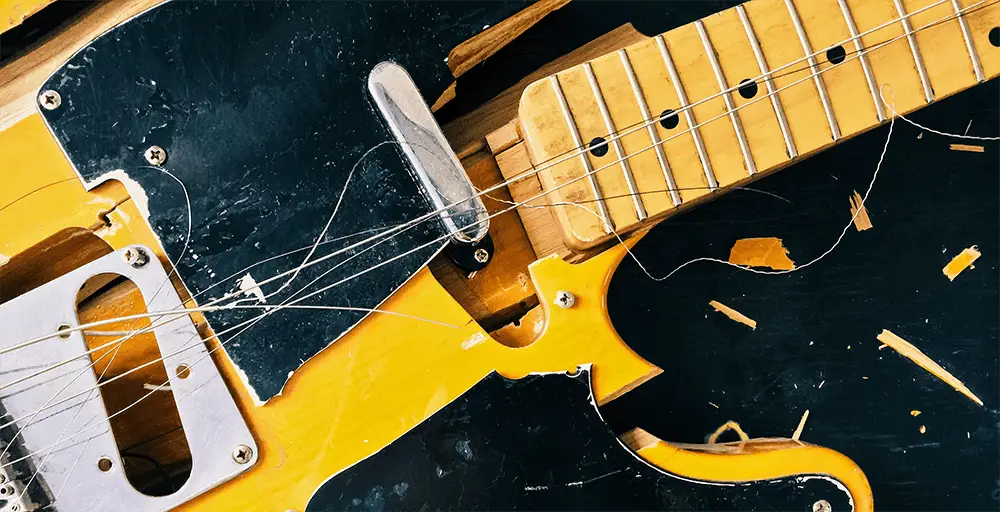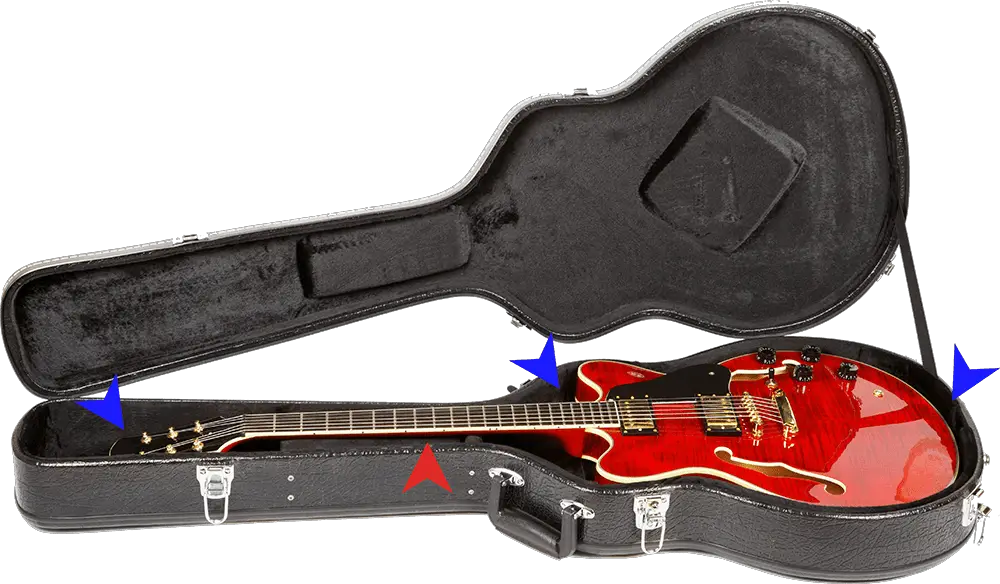
Flying with your guitar can be a nerve-wracking experience. You want to make sure that your beloved instrument arrives at your destination safe and sound. But with so many horror stories of guitars getting stolen, damaged, or lost in transit, it’s essential to be prepared.
Don’t let the fear of flying with your guitar hold you back from pursuing your music dreams. With the right knowledge and preparation, you can fly with confidence, knowing that your guitar will arrive at your destination in perfect condition.
This guide will arm you with all the information you need, from understanding airline policies to choosing the best guitar case for travel and packing tips for a smooth flight. Say goodbye to airport mishaps and hello to rockin’ out on stage with your trusty guitar by your side. So, let’s get ready to rock and roll with our guitars in tow!
Rockstar Regulations: Your Rights as a Passenger (EU and USA)
The best way to “battle” airport workers is by being prepared! Knowing your rights and having them in written form is the key to winning any argument on this subject. Don’t forget that as a passenger and a paying customer, you have rights! Arm yourself with this knowledge and navigate airport regulations with confidence. With this chapter, you’ll be ready to face any challenge that comes your way and ensure that your beloved instrument arrives at your destination in perfect condition.
Your Rights when flying with a guitar inside the USA

When flying with a guitar in the United States, the FAA Modernization and Reform Act of 2012 guarantees your right to bring your guitar on board as a carry-on item, as long as it fits in the overhead compartment or closet of the plane. This means that a normal bass, electric guitar, or acoustic/classical guitar should fit with no problem.
Be Prepared: Print and Carry a Copy of the FAA Law for Your Guitar Travel in the USA
‘‘(1) SMALL INSTRUMENTS AS CARRY-ON BAGGAGE – An air carrier providing air transportation shall permit a passenger to carry a violin, guitar, or other musical instrument in the aircraft cabin, without charging the passenger a fee in addition to any standard fee that carrier may require for comparable carryon baggage, if:
‘‘(A) the instrument can be stowed safely in a suitable baggage compartment in the aircraft cabin or under a passenger seat, in accordance with the requirements for carriage of carry-on baggage or cargo established by the Administrator.
AND
‘‘(B) there is space for such stowage at the time the passenger boards the aircraft.
Taken from the FAA Law, pages 72 and 217
Understanding the FAA Law:
- The first section states that passengers are allowed to bring a musical instrument as a carry-on without additional fees.
- Section A specifies that the instrument must be safely stowed in designated storage areas, such as the overhead compartment, the aircraft’s closet, or under your seat.
- Section B is crucial, as it states that there must be room on board for the instrument when you board the flight.
In summary, the FAA Modernization and Reform Act of 2012 guarantees your right to bring your guitar as a carry-on item as long as it fits in the overhead compartment or closet of the plane. However, if the flight is full, the airline may be gate-checking bags for the last boarders, which means you may be asked to check in your carry-on, including your guitar, with the rest of the flight’s baggage. To avoid this and ensure that your guitar has a guaranteed spot on board, it’s best to board early and be among the first to check-in.
If you find yourself running late for your flight, your best chance to bring your guitar on board is to approach the crew with a polite and friendly demeanor. Explain the importance and value of your guitar, and ask if it can be safely stowed in the onboard closets usually reserved for coats. Remember that being respectful and courteous can go a long way in convincing the crew to make an exception for your instrument.
To ensure your guitar has a guaranteed spot on board, consider upgrading to a “premium” seat, which typically guarantees a better boarding position for a small fee. This can ensure that your guitar has a guaranteed spot onboard and will be properly stowed for the flight.
USA airline policy list:
- ⭐️ Alaska Airlines guitar policy – Alaska Airlines is a musician-friendly airline, as reflected in their policy opening sentence “We know how important your musical instrument is to you, and we’ll treat it with extra care.” Their policy also includes a detailed table with all the necessary information, including size restrictions and any additional fees.
- JetBlue guitar policy – Board early as overhead bin space is on a first-come, first-served basis, and the aircraft does not have closets for stowing musical instruments. Consider purchasing a seat with extra space and priority boarding.
- Southwest guitar policy – Check that your instrument fits in the upper cabins and consider purchasing an extra seat or checking in your instrument for larger instruments. The maximum allowed size is 150 inches, including the case.
- American Airlines guitar policy – Pay attention to the maximum measurement for instruments allowed on board and check the plane type, as different models have different size restrictions.
- United Airlines guitar policy – Make sure your guitar is in a hard case or reinforced gig bag, as the company does not take responsibility for any damages in a soft case.
- Spirit Airlines guitar policy – Limited information is available on their website, so it’s best to contact customer service to ensure everything is in order.
- Delta Airlines guitar policy – Detailed information is provided on height, length, width, weight, and instructions for larger instruments.
- ⭐️ Air Canada guitar policy – Musician-friendly policy with specific instructions for air transport and preparing instruments for pressure and temperature changes.
Your Rights when flying with a guitar inside the EU

It’s important to note that the improvement of American law regarding flying musicians and their instruments does not apply in the EU. However, the European Commission has addressed this issue and now requires all airlines to publish specific information regarding air-traveling musicians and their instruments.
Be Prepared: Print and Carry a Copy of the EU law transcript.
Whereas (29). “Musical instruments should as far as possible be accepted as baggage within the passenger cabin and, where this is not possible, should where possible be carried under the appropriate conditions in the cargo compartment of the aircraft. In order to allow the passengers concerned to assess whether their instrument can be stored in the cabin, air carriers should inform them about the size of storage facilities. Regulation (EC) No 2027/97 should be amended accordingly.”
REGULATION OF THE EUROPEAN PARLIAMENT AND OF THE COUNCIL
Understanding the EU Law:
When flying with your guitar in the EU, it’s important to know the regulations and policies set by airlines. Although EU airlines are now required to provide information about carrying musical instruments, there is no law that obligates them to operate in a certain way, and additional fees may apply.
But don’t fret. With a bit of preparation, you can make sure your guitar gets a seat on the plane. Print and read up on the EU laws and the airline’s specific policies, and keep a copy in your guitar case. Pro tip: laminate it to keep it safe and sound. When it comes to boarding, aim to be one of the first on the plane to ensure your guitar gets a secure spot. If possible, upgrade your boarding priority to avoid any headaches.
EU airline policy list:
- ⭐️ EasyJet Guitar Policy – With EasyJet, you can bring your guitar on board as long as it is within the 120cm measurement limit. This makes flying with a guitar on EasyJet more affordable than other EU airlines.
With EasyJet, some bass guitars may fit within the measurement restrictions for carry-on items (including their case), while others may be slightly longer than the limit. For example, standard electric bass hard cases are typically around 126 cm in length, with some cases potentially being longer. - ⭐️ KLM Guitar Policy – KLM is a great option for musicians, as they allow instruments up to 158cm as hold luggage which is great news for bass players.
- Lufthansa Guitar Policy – Lufthansa allows you to bring your guitar on board instead of carry-on luggage. However, you may need to purchase an extra seat for both a carry-on and a guitar.
- Ryanair Guitar Policy – Ryanair’s policy states that you must purchase an extra seat for instruments such as a guitar. It may end up being more expensive than other options.
- Air France Guitar Policy – Air France allows you to check in your instrument as baggage, which means you can bring your guitar on board. However, you must notify customer service and get approval 48 hours before your flight.
- 👎 British Airways Guitar Policy – Unfortunately, British Airways does not allow guitars as carry-on, and you must purchase an extra seat for your instrument.
- 👎 Virgin Atlantic Guitar Policy – With Virgin Atlantic, you must purchase an extra seat for your guitar and can bring a maximum of 2 guitars (with a ticket for each).
Don’t Risk Damaging Your Guitar: The Ultimate Guide to Packing for Flight

Packing your guitar properly before a flight is crucial, especially if you’re traveling with an acoustic or semi-acoustic guitar. The rapid changes in pressure and temperature during a flight can cause cracks in the wood, so don’t take any chances! In this section, we’ll walk you through the process of properly packing your guitar for a flight, including choosing the right flight case and ensuring your guitar is protected against damage.
How to properly pack a guitar for a flight:
Don’t take the task of packing your guitar for a flight lightly – it’s crucial for the safety of your instrument and can save you from potential headaches.
- Insert a piece of paper between the strings and the neck to prevent the strings from scratching against the frets.
- Secure the headstock, neck, and heel with extra padding to keep the guitar in place within the case. You can use tees or other soft materials to achieve this.
- Loosen the strings to prevent any potential twisting of the neck.
- Don’t forget to bring important documents, such as the airline’s policy and any relevant laws, with you and keep them easily accessible (laminating them is a good idea for future reference).

“Fly with Your Guitar Like a Pro” – Tips and Tricks
Flying with a guitar can be a stressful experience, but it doesn’t have to be. Follow these tips, and you’ll be a pro at traveling with your instrument.
- Print and laminate all important documents – Keep a copy inside your case for easy access. This includes the FAA or EU law, the airline’s musical instrument policy, and your personal details.
- Choose a hard or flight case – If your guitar sustains damage during the flight, having it in a hard case will give you a stronger legal stance for damages.
- Research the airline’s specific policy – Every airline has different policies, so make sure you know the exact measurements and fees for bringing your instrument on board. Print this information and keep it in your case.
- Understand how instrument sizes are calculated – Some airlines calculate size based on length, height, and width altogether, while others have specific measurements for each dimension.
- Add an extra sticker with your details – In case your case gets lost, having your contact information on the outside will make it easier to track down.
- Check the plane type – Some smaller planes have smaller upper compartments, so double-check that your instrument will fit on the day of your flight.
- Consider purchasing an upgrade – It may be worth the extra cost for the convenience.
- Contact customer service for extra seat reservations – Be sure to properly fill in the seat information, such as using “extra” as the first name and “seat” as the last name.
- Standard hard case sizes – Electric guitar (105 x 41 x 13.5 cm), Acoustic guitar (116 x 49 x 16.6 cm), Electric bass guitar (126.5 x 41 x 14 cm), Acoustic bass guitar (113 x 46 x 16.5 cm)
- Keep a good attitude – Remember that even airport workers may not know all the rules, so approach them with a calm and friendly attitude. It can go a long way in getting the service you need.
THE ULTIMATE PRO TIP:
Guitars are at a much higher risk of getting stolen or damaged when touring, and that’s just a fact that any seasoned musician knows. What many professional touring guitar and bass players do to protect themselves is opt for modded guitars instead of expensive, one-of-a-kind instruments.
While still sounding amazing, such modded guitars won’t break your heart in case they get stolen or damaged on the road. These guitars may vary between $300 – $700 (depending on the model, a Les Paul style guitar with high-quality Boutique Humbuckers will be more expensive, while a Stratocaster Squier with Boutique single-coil pickups can go even under $300 if you find a good deal on it).
But the peace of mind and protection these modded guitars provide are truly priceless and an absolute must for any touring musician.
Protecting Your Investment: The Advantages of a Flight Case
When flying with your precious guitar, a good flight case is a non-negotiable. Not only does it provide the ultimate protection for your instrument during transport, but it also directly impacts the level of responsibility an airline will take in the event of damage. Investing in a sturdy, hard case can mean the difference between a successful claim and a broken heart. The extra weight and inconvenience are worth the peace of mind and added security for your beloved guitar.
When it comes to guitar cases, there are three main options: a soft gig-bag, a hard case, and a flight case. Each has its own advantages and disadvantages, and choosing the right one will depend on your specific needs and the type of travel you’ll be doing. On this list, you’ll find options for only hard cases and flight cases, as we recommend using these types of cases when flying with your instrument.
- The Fender Deluxe Molder Guitar Case for Strat/Tele! (also available for basses, jag/JM, and acoustic guitars).
This bad boy is built to withstand even the toughest of adventures with its ATA-molded military-grade polyethylene outer shell and TSA-approved locking center latch.
No need to worry about scratches or dings. It’s custom-fit for most Strat & Teles and has a cozy EPS protective foam interior nest and a high-quality gray polyester plush interior to keep your guitar safe and sound. Carry it with ease thanks to the ergonomic injection molded handle and the rugged injection molded polyethylene feet.
- The Gator Cases Deluxe Wood Case (available for all models).
Made with rugged plywood construction, this case is built to withstand the rigors of the road and keep your guitar safe and sound. The plush magenta interior with interior cover adds a touch of style and ensures that your guitar is cushioned and protected from scratches and dings. The traditional brown exterior gives this case a classic, timeless look that will never go out of style.
- The ChromaCast hard cases (available for all models).
These bad boys are built tough with durable wood construction and a plush-lined interior for extra neck and bridge support. Plus, the sturdy chrome latches and bumpers on the bottom and sides add extra protection and stability for your peace of mind.
It comes with a molded handle and a large accessory compartment. And the best part? You don’t have to break the bank to get this quality gear. So go ahead, gig away!
United Breaks Guitars: A Hilarious Protest Song Born from a Tragic Incident
A humorous incident occurred on a United Airlines flight when baggage handlers were caught carelessly tossing guitars instead of handling them properly. This prompted the formation of the “United Breaks Guitars” protest group, which wrote a song about the experience.






